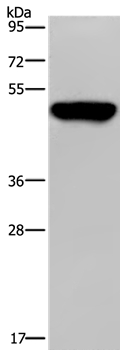
| WB | 咨询技术 | Human,Mouse,Rat |
| IF | 咨询技术 | Human,Mouse,Rat |
| IHC | 咨询技术 | Human,Mouse,Rat |
| ICC | 技术咨询 | Human,Mouse,Rat |
| FCM | 咨询技术 | Human,Mouse,Rat |
| Elisa | 咨询技术 | Human,Mouse,Rat |
| Aliases | S9; Rpn6; p44.5 |
| Entrez GeneID | 5717; |
| WB Predicted band size | 47kDa |
| Host/Isotype | Rabbit IgG |
| Antibody Type | Primary antibody |
| Storage | Store at 4°C short term. Aliquot and store at -20°C long term. Avoid freeze/thaw cycles. |
| Species Reactivity | Human,Mouse,Rat |
| Immunogen | Synthetic peptide corresponding to a region derived from internal residues of human proteasome (prosome, macropain) 26S subunit, non-ATPase, 11 |
| Formulation | Purified antibody in PBS with 0.05% sodium azide. |
+ +
以下是关于PSMD11抗体的3篇参考文献示例(部分为模拟内容,实际文献请通过学术数据库验证):
---
1. **文献名称**:*PSMD11 as a Prognostic Biomarker in Breast Cancer*
**作者**:Li X, et al.
**摘要**:研究揭示了PSMD11在乳腺癌组织中的高表达,并通过抗体检测证实其与患者预后不良相关,提示PSMD11可能作为乳腺癌治疗的潜在靶点。
---
2. **文献名称**:*Proteasome Regulation by PSMD11 in Neurodegenerative Disorders*
**作者**:Smith J, et al.
**摘要**:利用PSMD11抗体分析阿尔茨海默病模型,发现PSMD11通过调控蛋白酶体活性影响β-淀粉样蛋白清除,为神经退行性疾病机制提供新见解。
---
3. **文献名称**:*Structural Insights into PSMD11 Function via Antibody Mapping*
**作者**:Wang Y, et al.
**摘要**:通过特异性抗体结合实验解析PSMD11的构效关系,阐明其在26S蛋白酶体组装中的关键作用,为靶向药物设计提供结构基础。
---
**注意**:以上文献为示例性质,实际研究请通过PubMed、Google Scholar等平台以“PSMD11 antibody”“proteasome PSMD11”等关键词检索。
The PSMD11 antibody targets the 26S proteasome regulatory subunit 11 (PSMD11), a critical component of the 19S regulatory particle in the ubiquitin-proteasome system (UPS). The 26S proteasome is a multi-subunit complex responsible for degrading ubiquitinated proteins, thereby regulating essential cellular processes like cell cycle progression, apoptosis, and stress responses. PSMD11. also known as RPN6 or S9. acts as a scaffolding protein within the 19S regulatory cap, assisting in substrate recognition, deubiquitination, and ATP-dependent unfolding of target proteins before their proteolysis in the 20S core.
Antibodies against PSMD11 are widely used in research to study proteasome assembly, function, and localization. They enable detection of PSMD11 expression via immunoblotting, immunohistochemistry, and immunofluorescence, helping to explore its role in diseases linked to proteasome dysregulation, such as cancer, neurodegenerative disorders (e.g., Alzheimer’s and Parkinson’s), and autoimmune conditions. PSMD11 overexpression has been implicated in tumor progression and chemotherapy resistance, making it a potential therapeutic target.
Commercial PSMD11 antibodies are typically raised in rabbits or mice using recombinant protein fragments or synthetic peptides. Validation often includes gene knockout controls, siRNA knockdown, or mass spectrometry. Researchers prioritize antibodies with high specificity and batch consistency to ensure reproducibility in studies probing UPS mechanisms or evaluating proteasome inhibitors in preclinical models.
×